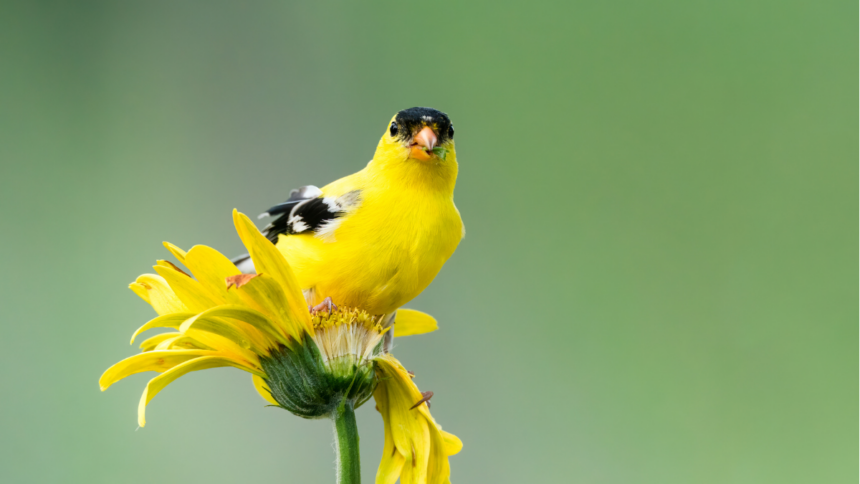Every spring and fall, billions of birds travel incredible distances along ancient migration routes called flyways. Squamish is part of the Pacific Flyway, stretching from Alaska, all the way to the tip of South America. Our estuaries, forests, and wetlands serve as critical stopover sites where birds can rest and refuel before continuing their journeys.
But these journeys are becoming harder. Since 1970, North America has lost nearly 3 billion birds—a staggering 29% decline in less than 50 years. The good news? Many of the biggest threats to migratory birds—glass collisions, light pollution, pesticides, and unsupervised cats—are challenges we can tackle together, starting in our own backyards.
Windows: The Invisible Killer
In Canada, window collisions kill 16 to 42 million birds a year. Birds cannot see glass as a barrier: they mistake reflections of trees and sky for real habitat or try to fly through clear panes.
Collisions don’t just happen at skyscrapers:
- Houses likely cause 90% of building-related mortalities
- Low-rise buildings account for 9%
- And high rise buildings account for the remaining 1%
Quick Fix: Add contrasting decals or patterns spaced no more than 5 cm apart on the outside of windows. Even treating a few problem windows can save lives. Find more solutions here.
Lights Out for Migrants
More than 80% of North America’s migratory birds travel at night, guided by the moon and stars. Artificial light disrupts their navigation, pulling them into towns and cities where they become disoriented, exhausted, or collide with glass.
What helps:
- Turn off unnecessary outdoor lights, especially during spring and fall migrations.
- Close curtains to reduce indoor light spill.
- Shield essential lights to reduce skyglow.
Even short dark periods—20–30 minutes—make a difference. Learn more here.
Pesticides: Hidden Poisons
From backyard gardens to large agricultural fields, pesticides are a silent but deadly threat.
- Today, neonicotinoids (“neonics”) are the most widely used pesticides on Earth. Just one coated seed can kill a songbird, while residues harm pollinators.
- Rodenticides like d-CON poison not just rats, but also the owls, hawks, and eagles that eat them.
What you can do: Avoid using pesticides at home. Choose bird- and pollinator-friendly alternatives, and support farmers working to reduce toxic chemicals. Learn more here.
Cats and Birds: A Shared Solution
Outdoor cats are beloved companions, but also skilled hunters. In Canada alone, cats kill 100–350 million birds annually—the single largest human-caused source of bird deaths. Cats themselves face serious outdoor risks: cars, predators, toxins, disease, and theft.
The solution is a win–win: keep cats indoors or supervised outdoors. Cats live longer, healthier lives—and wildlife stay safer. Learn more here.
Garden for Birds: Habitat at Home
Want to do more than reduce threats? You can actively create habitat for birds right in your yard or balcony garden.
- Food: Plant native shrubs and trees that produce berries, seeds, and nectar.
- Water: Add a birdbath or shallow water feature.
- Shelter: Provide shrubs, hedges, or nest boxes for cover and nesting.
Even small outdoor spaces can become part of a bigger conservation puzzle. When you garden with birds in mind, you’re helping counter habitat loss and biodiversity decline. And the bonus? You’ll attract butterflies, bees, salamanders, and other wildlife too.
🌱 Not sure where to start? Visit Birds Canada to find the best native plants for your yard and discover which surprising bird species might show up.
Three Ways Squamish Can Help Birds This Season
- Make Windows Bird-Safe with decals or patterns..
- Go Lights Out at night this migration season (September-November).
- Garden for Birds by planting native food and providing water and shelter sources.
And don’t forget: avoid pesticides, and keep cats safely indoors or supervised.
Join the Squamish Bird Team
Protecting migratory birds is a big task—but it’s also a community effort. By working together, we can make Squamish a safer place for birds to rest, feed, and thrive along the Pacific Flyway.
Our Squamish Bird Team brings together volunteers, nature lovers, and citizen scientists to:
- Help monitor bird populations and habitats
- Take part in projects that reduce threats to birds (like window safety, Lights Out campaigns, and habitat restoration)
- Share knowledge with our community about how everyone can help
Whether you’re an experienced birder or just curious about the feathered visitors in your backyard, you have a role to play.
👉 Interested in joining? Let us know through our volunteer form or sign up for our newsletter to learn about opportunities and local conservation efforts.

